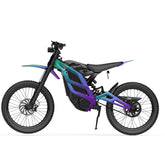Eco-Friendly Commuting: The Rise of Electric Scooters
Introduction: The Growing Need for Eco-Friendly Transportation
The world is rapidly transitioning towards more sustainable modes of transportation, and electric scooters have emerged as a key player in this revolution.
With growing concerns about pollution, traffic congestion, and the environmental impact of traditional vehicles, eco-friendly commuting options are gaining traction.
Electric scooters, in particular, have surged in popularity, providing a convenient, cost-effective, and environmentally friendly alternative for urban commuters.
This article explores the rise of electric scooters, their benefits, challenges, and their role in shaping the future of sustainable transportation.
What Are Electric Scooters?
Electric scooters (e-scooters) are two-wheeled vehicles powered by an electric motor, making them an alternative to traditional scooters or motorcycles.
They are lightweight, portable, and typically run on rechargeable batteries.
Unlike their gas-powered counterparts, e-scooters produce zero emissions, making them an ideal solution for reducing the carbon footprint of urban transportation.
E-scooters have evolved over the years, becoming more efficient, stylish, and user-friendly.
Available in various models, they cater to different commuter needs, ranging from short urban trips to longer-distance travel.
With compact designs and easy maneuverability, electric scooters are particularly popular in crowded cities where traffic congestion and parking can be major issues.
The Environmental Benefits of Electric Scooters
One of the biggest driving forces behind the adoption of electric scooters is their positive environmental impact.
Let's delve into the primary benefits that make electric scooters an eco-friendly transportation option:
1. Reduced Carbon Emissions
One of the most significant advantages of electric scooters is that they are powered by electricity rather than fossil fuels.
This makes them a zero-emission mode of transport, helping reduce air pollution and greenhouse gas emissions, especially in urban areas.
Unlike cars and motorcycles, which release harmful gases into the atmosphere, electric scooters operate cleanly, contributing to better air quality and a reduction in the urban heat island effect.
2. Lower Energy Consumption
Electric scooters are highly energy-efficient, consuming far less energy compared to cars or public transportation systems.
The energy required to charge an e-scooter is minimal, especially when compared to the energy needs of larger vehicles.
As the electricity grid becomes greener with more renewable energy sources, the environmental impact of charging electric scooters will continue to decrease.
3. Reduced Noise Pollution
Electric scooters produce significantly less noise than gas-powered vehicles.
In busy cities, noise pollution can be a major issue, impacting residents' quality of life.
E-scooters offer a quieter alternative, reducing the noise in urban spaces and making cities more livable.
4. Sustainable Battery Technology
With advancements in battery technology, many electric scooter manufacturers are using eco-friendly materials in their batteries, such as lithium-ion, which can be recycled.
The increased focus on battery recycling and sustainable production methods helps to reduce the environmental impact of electric scooters in the long term.
The Rise of Electric Scooters in Urban Areas
Electric scooters have become increasingly popular in urban environments due to their practicality and ease of use.
Let’s take a closer look at the factors driving their rise:
1. Convenience and Accessibility
E-scooters offer unparalleled convenience, especially for short commutes.
They are lightweight, foldable, and portable, allowing commuters to easily navigate through crowded streets, bike lanes, and public transportation systems.
Many cities have introduced e-scooter-sharing programs, which allow users to rent scooters on-demand via mobile apps, further increasing accessibility.
2. Traffic Congestion and Parking Issues
In major cities, traffic congestion is a major problem that contributes to long commute times, stress, and environmental damage.
Electric scooters provide an efficient way to bypass traffic jams.
They are small enough to be stored in tight spaces, reducing the need for large parking facilities.
This makes them a practical solution for navigating urban landscapes with limited parking options.
3. Cost-Effectiveness
Owning and operating an electric scooter is typically much cheaper than maintaining a car.
There are no fuel costs, and charging an e-scooter is far more affordable than refueling a vehicle.
Furthermore, scooter-sharing programs allow users to pay only for the time they use the scooter, making it an affordable option for those who need occasional transportation.
4. Government Support and Legislation
Many governments are actively encouraging the use of eco-friendly transportation, including electric scooters.
Some cities have created designated scooter lanes, implemented regulations to ensure safety, and provided financial incentives for people to switch to electric mobility.
This supportive infrastructure has been crucial in boosting the popularity of electric scooters.
Electric Scooters vs. Other Eco-Friendly Commuting Options
Electric scooters are not the only alternative to traditional vehicles.
Other options include bicycles, electric bikes, and electric cars.
Let’s compare the benefits of electric scooters to these alternatives:
1. Electric Scooters vs. Bicycles
Bicycles are another eco-friendly mode of transportation, but they require physical effort, which can be a barrier for some people.
E-scooters, on the other hand, are powered by electricity, making them ideal for those who want to avoid physical exertion while still enjoying the benefits of eco-friendly commuting.
E-scooters are also faster and more convenient for longer trips than bicycles, especially in areas with hilly terrain.
2. Electric Scooters vs. Electric Bikes (E-Bikes)
E-bikes are another popular eco-friendly option, providing a mix of pedal power and motor assistance.
While e-bikes offer more range and can be used for longer distances, they are also more expensive and heavier than electric scooters.
Scooters are easier to park and maneuver in crowded areas, making them a better option for short urban commutes.
3. Electric Scooters vs. Electric Cars
Electric cars are a sustainable alternative to traditional gas-powered vehicles, but they require more resources to produce and are significantly more expensive.
While electric cars are better suited for long-distance travel and carrying passengers, electric scooters are ideal for short, urban trips.
They are more affordable, require less infrastructure, and have a smaller environmental footprint when compared to electric cars.
Challenges Facing the Adoption of Electric Scooters
Despite their many benefits, electric scooters face several challenges that hinder their widespread adoption.
Let’s explore some of the main obstacles:
1. Safety Concerns
Safety remains one of the most significant concerns surrounding electric scooters.
Accidents involving scooters can result in serious injuries, especially in cities with poorly maintained infrastructure or high traffic density.
Governments and manufacturers are working to address these concerns by implementing safety regulations, improving scooter designs, and increasing awareness about proper riding techniques.
2. Infrastructure Limitations
The lack of dedicated infrastructure for electric scooters, such as bike lanes or charging stations, can make it difficult for users to fully embrace this mode of transport.
Many cities are starting to address this issue by building more bike lanes and offering charging stations, but the rollout is still in its early stages in many places.
3. Battery Life and Charging
Although electric scooters are energy-efficient, their range is limited by the battery life.
For longer commutes, users may find themselves needing to recharge during the day.
The availability of charging stations is also limited in many areas, which can deter people from relying on electric scooters for daily transportation.
4. Environmental Impact of Manufacturing
While electric scooters themselves are environmentally friendly, the manufacturing process, particularly the production of batteries, can have a significant environmental impact.
However, advancements in sustainable manufacturing practices and battery recycling are helping to mitigate these effects over time.
The Future of Electric Scooters
As electric scooters continue to grow in popularity, the future looks bright for this mode of transportation.
With ongoing advancements in technology, infrastructure, and public awareness, electric scooters are expected to become a mainstream commuting option in urban areas worldwide.
Future innovations may include:
- Improved Battery Technology: Longer-lasting, faster-charging batteries will help extend the range and usability of electric scooters.
- Smarter Scooters: Integration with AI and IoT technologies will enable more efficient routing, predictive maintenance, and better fleet management for shared scooters.
- Wider Adoption: As more cities implement regulations and infrastructure for electric scooters, they will become a staple in sustainable urban mobility.
Conclusion: Embracing the Future of Eco-Friendly Commuting
Electric scooters represent a pivotal shift towards greener, more sustainable transportation solutions.
Their convenience, affordability, and environmental benefits make them an attractive option for urban commuters looking to reduce their carbon footprint.
However, challenges such as safety concerns, infrastructure limitations, and battery life still need to be addressed to ensure that electric scooters can reach their full potential.
As the adoption of electric scooters continues to grow, they are poised to play an essential role in the future of eco-friendly commuting.
With continued advancements in technology and infrastructure, we can look forward to a more sustainable and efficient urban transportation landscape.
FAQs
-
Are electric scooters safe to use?
- Electric scooters can be safe when used properly. Wearing protective gear, such as helmets, following traffic rules, and riding responsibly can reduce the risk of accidents.
-
How far can I travel on an electric scooter?
- The range of an electric scooter depends on the model and battery capacity. Most e-scooters offer a range of 15-30 miles on a single charge.
-
How long does it take to charge an electric scooter?
- Charging times typically range from 3 to 6 hours, depending on the scooter’s battery capacity and the charger being used.
-
Can electric scooters be used in rainy weather?
- Many electric scooters are water-resistant, but it is advisable to avoid riding in heavy rain to prevent damage to the electrical components and reduce the risk of slipping.
-
What are the benefits of scooter-sharing programs?
- Scooter-sharing programs offer a cost-effective, convenient, and eco-friendly transportation option without the need to purchase and maintain an electric scooter. These services are especially useful for short trips and reducing traffic congestion.











